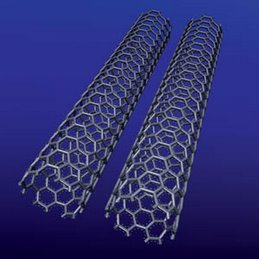
"Nanograss" Provides Precise Fluid Control :
Scientists at Bell Labs (Murray Hill, N.J.), the R&D arm of Lucent Technologies, have discovered a new method to control the behavior of tiny liquid droplets by applying electrical charges to specially engineered silicon surfaces that resemble blades of grass.
The new technique of manipulating fluids has many potential applications, including thermal cooling of ICs, novel photonic components, and small, low-cost "lab-on-a-chip" sensor modules.
Nanograss as Coolant in electronics circuits:
Krupenkin and his team coated the nanograss with a non-stick, water-repellent material, and when the droplets are put on the surface, they can move about without wetting it. By applying a small voltage, however, the team could tailor the behavior of droplets, making them sink in and wet the surface as directed. The droplets also respond to a change in temperature, allowing for thermal cooling applications.
"Such behavior may be harnessed to cool computer chips," Krupenkin said. "A droplet could be sent to a hot spot on the chip, where it would sink in and absorb the heat, and then go on its way, avoiding the expense and inefficiency of applying a coolant or a heat sink to an entire chip."
Nanograss in Optical Networking:
Another application for this technique may be in optical networking. For example, moving a droplet of fluid into a nanograss surface can alter the physical properties of the transmitting medium through which light signals are sent, and this may lead to better methods for optical switching. Novel optical components, such as filters, could be created by moving the fluid into and out of nanograss areas, Krupenkin said.
Bell Labs and the New Jersey Nanotechnology Consortium are also exploring using the nanograss technique to create next-generation microbatteries. Conventional batteries have electrochemical reactions proceeding at some level all the time, even when batteries are not being used. Over time, the batteries degrade. By using the Bell Labs technique to isolate the liquid electrolyte so that electrochemical reactions do not take place until power is actually needed, nanograss-based microbatteries may be ideal for long-term, higher-capacity battery applications, especially where bursts of power are needed.
Yet another application for the nanograss may be "lab-on-a-chip" devices. "Potentially, one can envision lab-on-the-chip devices that use thousands of different reagents, each deposited in a small spot at the bottom of the nanograss, thus providing novel devices for combinatorial chemistry, genetic analysis, and so on," Krupenkin said. "Some other possible applications where nanograss can be used may be for low-friction torpedoes, self-cleaning windshields, and faster boats where the fluid-repellent properties of the nanograss would be important."
Other members of the interdisciplinary team involved in the research were Ashley Taylor of Bell Labs, Bell Labs intern Tobias Schnieder, and University of Pennsylvania professor Shu Yang.
Courtesy : Peter Singer, Editor-in-Chief --document.write(get_publication('Semiconductor International')); Semiconductor International.



1 comment:
Use of nano technology in all industries increasing day by day. Nano technology is used in Chemical, Metal, Power, Infrastructure,Manufacturer,Textile industry. What is use of Copper Cathode in agriculture industry?
Post a Comment